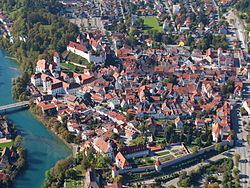Admin. region Schwaben Elevation 808 m (2,651 ft) Population 14,236 (31 Dec 2008) | Time zone CET/CEST (UTC+1/+2) Local time Sunday 12:21 AM | |
 | ||
Weather 7°C, Wind SW at 19 km/h, 90% Humidity Points of interest | ||
Germany f ssen bavaria hd video
Füssen is a town in Bavaria, Germany, in the district of Ostallgäu, situated 5 kilometres (3.1 mi) north from the Austrian border. It has a population of 15,265. The town is known for its violinmaking industry, and as the closest transportation hub for the castles Neuschwanstein and Hohenschwangau.
Contents
- Germany f ssen bavaria hd video
- Map of FC3BCssen Germany
- Travel germany f ssen neuschwanstein castle more
- History
- Recent history
- Geography
- Attractions
- Local media
- Notable residents
- Twinned towns
- References
Map of F%C3%BCssen, Germany
Travel germany f ssen neuschwanstein castle more
History
Füssen was settled in Roman times, on the Via Claudia Augusta, a road that leads southwards to northern Italy and northwards to Augusta Vindelicum (today's Augsburg), the former regional capital of the Roman province Raetia. The original name of Füssen was "Foetes", or "Foetibus" (inflected), which derives from Latin "Fauces", meaning "gorge", probably referring to the Lech gorge. In Late Antiquity Füssen was the home of a part of the Legio III Italica, which was stationed there to guard the important trade route over the Alps.
Füssen later became the site of the "Hohes Schloss" (High Castle), the former summer residence of the prince-bishops of Augsburg. Below the Hohes Schloss is the Baroque complex of the former Benedictine monastery of St. Mang, whose history goes back to the 9th century. Füssen has Saint Mang (Magnus of Füssen) as its patron saint. He and his Benedictine brother Theodor were two monks from the Abbey of Saint Gall and are considered to be its founders, in addition to the Monastery of Kempten. Magnus' original burial place was in the small chapel he built. His bones were transferred to the crypt of the church built in 850. Around the year 1100 all his bones disappeared.
.
In 1745, the Treaty of Füssen was signed between the Electorate of Bavaria and Habsburg Austria, ending Bavaria's participation in the War of the Austrian Succession.
During the 19th century, composer Richard Wagner used to come to Füssen by railway when he visited King Ludwig II of Bavaria.
Recent history
Under the Nazi Party, Füssen was within the administrative division of Gau Swabia. During World War II, a sub-camp of the Dachau concentration camp was located in the town.
Since the 1950s the town has been familiar to travellers as the southern terminus of the Romantic Road. Füssen was host to the 1988 World Junior Curling Championships.
Geography
Füssen is located on the banks of the Lech River, which flows into the Forggensee. The Forggensee is a man-made lake which was built to prevent flooding. It is the catchment area for all the melting snow in the spring, and is drained after the middle of October.
Füssen is the highest town in Bavaria, 808 meters (2,651 ft) above sea level). The castles of Neuschwanstein and Hohehschwangau are located near the town.
.
Attractions
The High Castle houses a branch gallery of the Bavarian State Collections of Paintings, which focuses on late Gothic and Renaissance works of art.
The oldest fresco in Germany can be found in the crypt of St Mang's Basilica. It dates back to about the year 980.
St Mang's Feast Day (6 September) is commemorated with a Holy Mass followed by a procession by torchlight through the old part of the city. During the week of the Saint's Feast a special 'Magnus Wine' is sold, with only 500 bottles produced.
Known beyond Füssen is the success of EV Füssen, the local Oberliga ice hockey club.
Local media
The local newspaper for Füssen is the Allgäuer Zeitung, printed daily except Sundays and on Holy Days of Obligation. It contains a special section with news from Füssen and the surrounding towns and villages called the Füssener Blatt.
Notable residents
Twinned towns
Füssen is twinned with:
